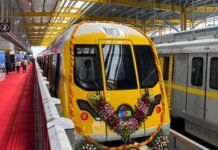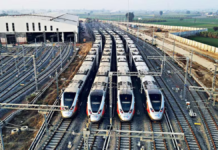New Delhi, Metro Rail News: To Provide hassle-free connectivity and in a major boost for regional mobility in the National Capital Region (NCR), the Haryana Cabinet has approved the detailed project report (DPR) of the Delhi-Gurugram-SNB (Shahjahanpur-Neemrana-Behror Urban Complex) Regional Rapid Transit System (RRTS) corridor yesterday.
For the financial year 2019-20, the Cabinet approved a seed capital of Rs 500 crore which will come from the state exchequer. The Cabinet also approved the gross contribution of Rs 6,436 crore for the project.
In addition, the slab of purchasable floor area ratio (FAR) was raised to 1.25 within 1.5 km of the RRTS corridor. The National Capital Region Transport Corporation (NCRTC) Board, which is the implementing agency for the project, had approved the Delhi-Gurugram-SNB corridor (106km) detailed project report in December 2018.
One of the three RRTS corridors prioritized for implementation, Delhi-Gurugram-SNB corridor is planned to be implemented in three phase.
In Phase 1, Delhi-Gurugram-SNB Urban Complex will be constructed. In Phase 2, it will be extended from SNB Urban Complex to Sotanala and in Phase 3 SNB Urban Complex to Alwar will be constructed.
Pre-construction work is already started such as geotechnical investigation has recently commenced in Gurugram. Tenders for pile loading test have also been floated by NCRTC for Delhi-Gurugram-SNB corridor.
Delhi-Gurugram-SNB corridor will be elevated for 71 km (11 stations) and the remaining 35 km (5 stations) will be constructed underground, primarily in Delhi and Gurugram
This corridor will connect with other RRTS corridors in Sarai Kale Khan and will be ability, facilitating commuters’ movement from one corridor to another hassle free of changing trains.
Likewiase, with an intent to
The operation speed of RRTS trains will be 160 km/ph and
The RRTS trains will be air-conditioned with transverse seating and overhead luggage space for commuter comfort. There would be priority seating arrangements for people with special needs and a business class coach and ladies coach in every train.
The RRTS smart line will pass through the urbanised and industrialised areas of Haryana and connect Delhi airport with the RRTS network, increasing the overall productivity of NCR.
The corridor will strengthen the regional transport infrastructure by providing a fast, safe, comfortable and reliable mobility option to the residents of Delhi, Gurugram, Rewari, Manesar, Daruheda, Bawal, and nearby areas.
The fast commute connecting Delhi to nearby regions will be immensely beneficial in decongesting Delhi and its roads, providing citizens the choice to live and work in different regions, according to a press release.
Once constructed, the corridor is expected to bring down the travel time between Delhi-SNB to about 70 minutes.
This corridor will not only offer mass transit benefits but also bring in the wide range of economic benefits to the society, including effectively curbing pollution, improving safety and reliability of commute and creating employment as well as new economic opportunities, the release said.






